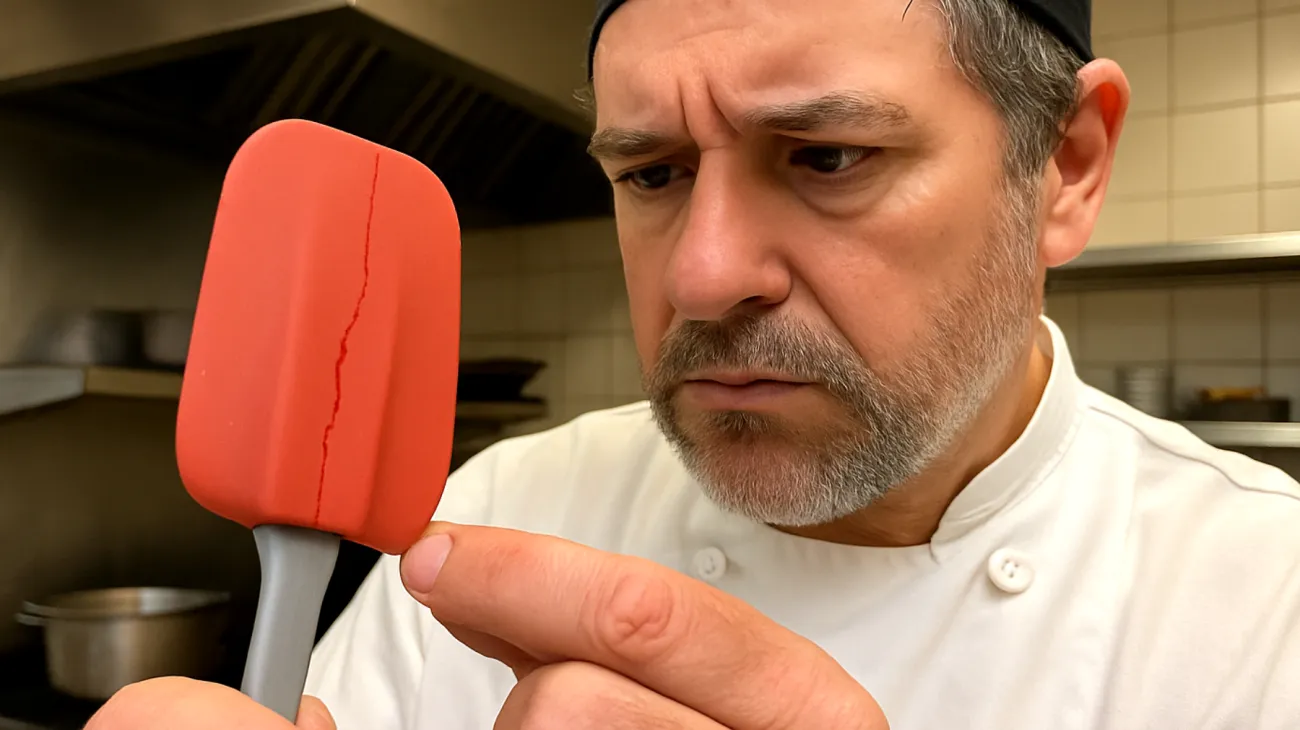Silicone spatulas, with their heat resistance, flexibility, and non-scratch surfaces, have become essential tools in modern kitchens. But their very malleability — the soft edges that make them perfect for scraping bowls clean — also makes them vulnerable to structural wear when stored haphazardly. Tossed into cluttered drawers, they get bent, pressed, and lost among heavier utensils, creating daily frustration that goes far beyond simple inconvenience.
The problem isn’t about having too many tools — it’s about the lack of storage systems that respect silicone’s unique material properties. Unlike rigid metal whisks or wooden spoons, silicone spatulas maintain their shape through molecular elasticity rather than structural rigidity. This means prolonged pressure or awkward positioning can exceed their elastic memory threshold, leading to permanent warps and creases that compromise cooking performance.
Professional chefs have long understood that tool condition directly impacts cooking results, which is why commercial kitchens invest heavily in proper storage systems. The same principles can transform home kitchens, protecting investments while streamlining daily cooking routines.
Why Silicone Spatulas Demand Special Attention
The flexibility that allows silicone spatulas to conform perfectly to bowl contours becomes a liability when storage systems don’t account for material behavior. Temperature variations compound these challenges — kitchen environments subject silicone to constant thermal cycling from refrigerated ingredients to stovetop heat, then back to room temperature during storage. Each cycle creates microscopic stress within the material structure.
Poor storage creates cascading problems that affect both efficiency and food safety. Structural integrity suffers when spatulas are wedged under heavy utensils or shoved into shallow drawers without support. The deformations that result compromise scraping efficiency and create stress concentration points where tools eventually fail.
Contamination risks increase substantially in disorganized environments. Loose storage allows spatulas to contact drawer bottoms that collect food particles, uncleaned utensils, or non-kitchen items. The soft, slightly textured surface of silicone traps particles and bacteria more readily than smooth metal surfaces, making proper separation crucial for food safety.
Strategic Drawer Organization Solutions
The challenge extends beyond simply fitting spatulas somewhere — it requires deliberate space allocation that respects their unique shapes and material properties. Modern kitchen organization research identifies several key principles: tools should maintain their functional shape during storage, frequently used items require easy access without disturbing other tools, and storage systems must protect while maintaining hygiene standards.
Adjustable drawer dividers represent one of the most versatile solutions for spatula storage. These systems allow customization of compartments to match spatula sizes and shapes while preventing the overcrowding that leads to deformation. Quality dividers feature silicone or rubber edges that anchor securely, preventing the shifting that occurs as drawers open and close throughout daily use.
Utensil trays with deep, molded slots offer another effective approach. Unlike flat generic trays, these specialized organizers cradle and separate curved or flexible utensils without applying pressure. Deep slots accommodate various spatula head sizes while keeping handles easily accessible, and the separation promotes better air circulation that reduces moisture retention.
Vertical pegboard systems in deep drawers maximize space while providing excellent visibility and access. The vertical orientation allows spatulas to stand upright within custom-configured zones, and this positioning naturally maintains proper shape while making tools immediately identifiable during cooking.
Countertop Storage for Active Cooks
Some kitchens face fundamental space constraints that make drawer storage inadequate, while other cooks prefer having their most-used tools within immediate reach during active cooking sessions. Strategic countertop storage requires careful consideration of both functionality and hygiene, since visibility that makes tools easily accessible also exposes them to cooking vapors and potential contamination.
Successful countertop storage depends on selectivity. Not every spatula should occupy precious counter space permanently — the most effective approach involves identifying the five to seven most frequently used tools and establishing dedicated storage for these while maintaining proper drawer organization for the remainder.
Handle-down, head-up orientation is critical for countertop storage. This positioning protects the food-contact surface from moisture or contaminants that accumulate in container bases, while providing better tool identification and easier access during cooking. Container selection impacts both function and safety — weighted or wide-base crocks prevent tipping, especially important when storing larger utensils alongside delicate silicone spatulas.
![]()
Advanced Organization for Serious Cooks
Extensive spatula collections require sophisticated organization strategies that go beyond basic storage solutions. Functional categorization becomes essential with larger collections — establishing groups based on cooking tasks creates logical systems that improve both storage efficiency and cooking workflow.
- High-heat cooking spatulas near stovetop areas for quick access during searing and sautéing
- Delicate baking tools protected from harder implements and stored near mixing preparation areas
- Specialty scrapers for specific techniques grouped separately and rotated into primary storage as needed
- Seasonal tools stored separately and rotated into primary positions during holiday baking or special projects
Task-specific zoning optimizes kitchen workflow by creating logical connections between tools and their primary uses. Baking spatulas with softer heads designed for room-temperature work benefit from storage near mixing bowls and ingredient preparation areas, while high-temperature tools need quick access from cooking positions.
Material Science and Long-term Care
Understanding silicone’s molecular properties provides insights for optimizing storage strategies. The polymer structure that gives silicone its valuable cooking properties also creates specific vulnerabilities that proper storage addresses. Compression sensitivity affects storage positioning — while silicone exhibits excellent elasticity, prolonged compression can exceed recovery limits, leading to permanent deformation.
Thermal considerations extend beyond obvious heat sources. Storing spatulas near warm appliances, sunny windows, or heating vents creates thermal stress over time. Even moderate temperature variations can accelerate material fatigue, particularly in lower-grade silicone formulations. Storage areas should remain clean and dry, avoiding contact with harsh cleaning residues that can affect surface properties.
UV exposure presents an often-overlooked degradation pathway. Natural or artificial light gradually breaks down polymer chains in silicone, leading to brittleness and reduced flexibility. Storage in closed drawers or opaque containers provides essential protection from light exposure that extends tool life significantly.
Creating Systems That Actually Work
The most effective spatula storage solutions integrate seamlessly into broader kitchen organization systems rather than existing as isolated solutions for individual tool categories. Successful organization creates coherent systems that adapt to changing needs while maintaining core organizational principles.
Flexibility remains crucial for long-term success since kitchen tool collections evolve as cooking interests develop and techniques improve. Storage systems should accommodate growth and change without requiring complete reorganization, while maintenance requirements must align with realistic household routines.
Cost-effectiveness balances investment with benefits. While specialized storage solutions may require initial expenditure, the protection they provide for quality tools, combined with improved kitchen efficiency, typically justifies the investment over time. Stackable storage options offer particular value by maximizing space utilization while providing modular flexibility.
- Drawer dividers that adjust to accommodate changing tool collections
- Modular countertop containers that stack or nest when not in use
- Vertical storage systems that maximize space efficiency
- Hybrid solutions that combine drawer and countertop storage for optimal workflow
Maintenance integration ensures storage systems support rather than hinder proper tool care. Effective storage works hand-in-hand with cleaning routines to maximize spatula longevity and performance. Tools stored in enclosed spaces require thorough drying to prevent bacterial growth, while countertop storage necessitates more frequent cleaning due to exposure to cooking environments.
Storage position can facilitate or hinder proper drying after cleaning. Vertical storage promotes drainage and air circulation, while horizontal storage in closed compartments may trap moisture. Matching storage methods to cleaning routines optimizes both processes and ensures tools remain in peak condition.
A well-organized kitchen drawer doesn’t just look good — it performs better, saving seconds during prep while preventing problems through proper tool care. Whether you choose drawer organization, countertop storage, or hybrid systems, the best method balances accessibility with preservation. Small tools like silicone spatulas may not demand immediate attention, but their longevity and usefulness depend entirely on how they rest between uses. With thoughtful storage solutions, your spatulas will remain properly shaped, easily accessible, and ready to handle any culinary challenge you present.
Table of Contents

